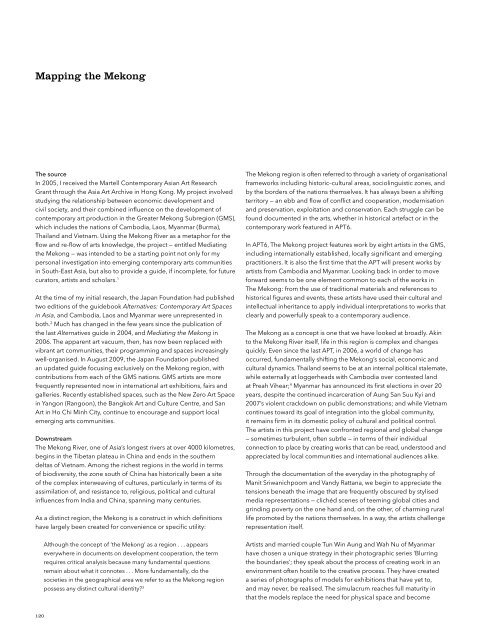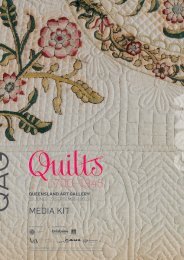Queensland Art Gallery - Queensland Government
Queensland Art Gallery - Queensland Government
Queensland Art Gallery - Queensland Government
Create successful ePaper yourself
Turn your PDF publications into a flip-book with our unique Google optimized e-Paper software.
Mapping the Mekong<br />
The source<br />
In 2005, I received the Martell Contemporary Asian <strong>Art</strong> Research<br />
Grant through the Asia <strong>Art</strong> Archive in Hong Kong. My project involved<br />
studying the relationship between economic development and<br />
civil society, and their combined influence on the development of<br />
contemporary art production in the Greater Mekong Subregion (GMS),<br />
which includes the nations of Cambodia, Laos, Myanmar (Burma),<br />
Thailand and Vietnam. Using the Mekong River as a metaphor for the<br />
flow and re-flow of arts knowledge, the project — entitled Mediating<br />
the Mekong — was intended to be a starting point not only for my<br />
personal investigation into emerging contemporary arts communities<br />
in South-East Asia, but also to provide a guide, if incomplete, for future<br />
curators, artists and scholars. 1<br />
At the time of my initial research, the Japan Foundation had published<br />
two editions of the guidebook Alternatives: Contemporary <strong>Art</strong> Spaces<br />
in Asia, and Cambodia, Laos and Myanmar were unrepresented in<br />
both. 2 Much has changed in the few years since the publication of<br />
the last Alternatives guide in 2004, and Mediating the Mekong in<br />
2006. The apparent art vacuum, then, has now been replaced with<br />
vibrant art communities, their programming and spaces increasingly<br />
well-organised. In August 2009, the Japan Foundation published<br />
an updated guide focusing exclusively on the Mekong region, with<br />
contributions from each of the GMS nations. GMS artists are more<br />
frequently represented now in international art exhibitions, fairs and<br />
galleries. Recently established spaces, such as the New Zero <strong>Art</strong> Space<br />
in Yangon (Rangoon), the Bangkok <strong>Art</strong> and Culture Centre, and San<br />
<strong>Art</strong> in Ho Chi Minh City, continue to encourage and support local<br />
emerging arts communities.<br />
Downstream<br />
The Mekong River, one of Asia’s longest rivers at over 4000 kilometres,<br />
begins in the Tibetan plateau in China and ends in the southern<br />
deltas of Vietnam. Among the richest regions in the world in terms<br />
of biodiversity, the zone south of China has historically been a site<br />
of the complex interweaving of cultures, particularly in terms of its<br />
assimilation of, and resistance to, religious, political and cultural<br />
influences from India and China, spanning many centuries.<br />
As a distinct region, the Mekong is a construct in which definitions<br />
have largely been created for convenience or specific utility:<br />
The Mekong region is often referred to through a variety of organisational<br />
frameworks including historic–cultural areas, sociolinguistic zones, and<br />
by the borders of the nations themselves. It has always been a shifting<br />
territory — an ebb and flow of conflict and cooperation, modernisation<br />
and preservation, exploitation and conservation. Each struggle can be<br />
found documented in the arts, whether in historical artefact or in the<br />
contemporary work featured in APT6.<br />
In APT6, The Mekong project features work by eight artists in the GMS,<br />
including internationally established, locally significant and emerging<br />
practitioners. It is also the first time that the APT will present works by<br />
artists from Cambodia and Myanmar. Looking back in order to move<br />
forward seems to be one element common to each of the works in<br />
The Mekong: from the use of traditional materials and references to<br />
historical figures and events, these artists have used their cultural and<br />
intellectual inheritance to apply individual interpretations to works that<br />
clearly and powerfully speak to a contemporary audience.<br />
The Mekong as a concept is one that we have looked at broadly. Akin<br />
to the Mekong River itself, life in this region is complex and changes<br />
quickly. Even since the last APT, in 2006, a world of change has<br />
occurred, fundamentally shifting the Mekong’s social, economic and<br />
cultural dynamics. Thailand seems to be at an internal political stalemate,<br />
while externally at loggerheads with Cambodia over contested land<br />
at Preah Vihear; 4 Myanmar has announced its first elections in over 20<br />
years, despite the continued incarceration of Aung San Suu Kyi and<br />
2007’s violent crackdown on public demonstrations; and while Vietnam<br />
continues toward its goal of integration into the global community,<br />
it remains firm in its domestic policy of cultural and political control.<br />
The artists in this project have confronted regional and global change<br />
— sometimes turbulent, often subtle — in terms of their individual<br />
connection to place by creating works that can be read, understood and<br />
appreciated by local communities and international audiences alike.<br />
Through the documentation of the everyday in the photography of<br />
Manit Sriwanichpoom and Vandy Rattana, we begin to appreciate the<br />
tensions beneath the image that are frequently obscured by stylised<br />
media representations — clichéd scenes of teeming global cities and<br />
grinding poverty on the one hand and, on the other, of charming rural<br />
life promoted by the nations themselves. In a way, the artists challenge<br />
representation itself.<br />
Although the concept of ‘the Mekong’ as a region . . . appears<br />
everywhere in documents on development cooperation, the term<br />
requires critical analysis because many fundamental questions<br />
remain about what it connotes . . . More fundamentally, do the<br />
societies in the geographical area we refer to as the Mekong region<br />
possess any distinct cultural identity? 3<br />
<strong>Art</strong>ists and married couple Tun Win Aung and Wah Nu of Myanmar<br />
have chosen a unique strategy in their photographic series ‘Blurring<br />
the boundaries’; they speak about the process of creating work in an<br />
environment often hostile to the creative process. They have created<br />
a series of photographs of models for exhibitions that have yet to,<br />
and may never, be realised. The simulacrum reaches full maturity in<br />
that the models replace the need for physical space and become<br />
Jun Nguyen-Hatsushiba<br />
Japan/United States/Vietnam b.1968<br />
The Ground, the Root, and the Air: The Passing of the<br />
Bodhi Tree (still) 2004–07<br />
High-definition digital video, single channel, colour, sound,<br />
14:30 minutes / Image courtesy: The artist; The Quiet in the<br />
Land, Laos; Mizuma <strong>Art</strong> <strong>Gallery</strong>, Tokyo; Lehmann Maupin<br />
<strong>Gallery</strong>, New York / Photograph: Yukari Imai<br />
120 121
















